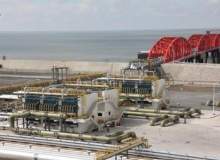
Jiangsu LNG Project is located on an artificial island in the Rudong County of China’s Jiangsu province. It includes a liquefied natural gas (LNG) receiving terminal and related infrastructure.
The project is being jointly developed by PetroChina (55%), Pacific Oil & Gas (35%) and the Jiangsu Guoxin Investment Group (ten percent) with an estimated investment of $952m.
Construction is being carried out in two phases. The first phase was officially completed in November 2011. First cargo was delivered to the terminal from Qatar in May 2011 by the Q-Flex LNG carrier Al Rekayyat. Phase one has an annual capacity of 3.5mt.
Phase two is scheduled for completion by the end of 2013 and will increase the capacity of the plant to 6.5mt. The plant is designed for a maximum capacity of 10mt.
China is focusing on improving energy security and increasing the use of cleaner burning fuels to reduce pollution rates. The Jiangsu LNG project was undertaken to address this need. It will fulfil energy demand in the Jiangsu province and promote the development of the local economy.
Jiangsu liquefied natural gas (LNG) project design and details
The project includes an LNG terminal, a jetty, a pierhead trestle and a sea-crossing pipeline. The artificial island built for the project occupies an area of 0.3 square kilometres.
The terminal includes LNG unloading, storage, regasification and gas metering facilities. The first phase of the project includes the construction of three 160,000 cubic metre storage tanks, a stage, three open rack vaporisers (ORVs), three submerged combustion vaporisers (SCVs), three 20in unloading arms and one return arm. Phase two of the project will add one ORV and SCV to the terminal.
The 1,970m pierhead trestle links the LNG terminal with the jetty. It is the longest trestle in China and the second longest in the world. The trestle includes ten compensator piers and nine anchor piers. It also includes 20 steel trestle sections, each 86.8m in length and 12.5m wide. The maximum truss height at the middle of each section is 11.5m. Each section weighs about 350t.
The jetty is 430m long and includes a working platform, four mooring dolphins, six bollards and a steel trestle for pedestrians. It can berth LNG carriers with a capacity of 80,000 cubic metres to 267,000 cubic metres.
The sea-crossing pipeline is 19km long, 1,016mm in diameter and 26.2mm thick. It includes a normal section, a sea-crossing bridge section and an off-take station. Annual capacity of the pipeline is 10mt of gas.
Construction agreement between the Jiangsu government and PetroChina
Government of Jiangsu province and PetroChina signed an agreement to develop the project in 2005. Construction of the artificial island for the project started in January 2007. By November 2007, land for the terminal block was successfully reclaimed.
Tank installation commenced in March 2009 and by April 2009 the first piece of the first tank vault was hoisted in place. The second tank was installed in September 2010. The sea-crossing pipeline was completed in June 2011.
West-East Gas Pipeline and Shaan-Jing pipeline terminal connections
The Jiangsu terminal is connected to the West-East Gas Pipeline and the Jining branch of the Shaan-Jing pipeline through gas trunks. The 3,843km long West-East Gas Pipeline became operational in 2004 and delivers gas to the central and eastern regions of China. The Shaan-Jing pipeline delivers gas to Beijing and the provinces of Shanxi, Hebei and Tianjin.
Contractors involved in the Chinese liquefied natural gas (LNG) project
Whessoe carried out the feasibility studies for the project. WorleyParsons was appointed as the project manager.
Kogas was responsible for providing commissioning, training and consulting services for operation and maintenance of the plant.
Meyts Structural Consulting and Technodyne were involved in the construction of the tanks of the terminal. In 2009, Poyam Valves was awarded a contract to supply various valves for the project. ARES supplied its KRYBAR steel for one of the tanks of the terminal. The ORVs were supplied by Sojitz Machinery.
Torishima Pump Manufacturing supplied four sea water pumps. Marimatech provided the laser docking systems. Compressors were supplied by Burckhardt Compression.



